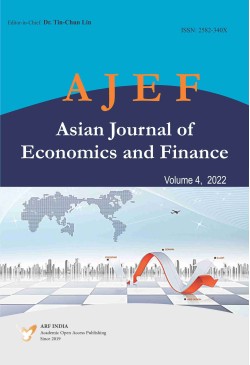
Asian Journal of Economics and Finance
Frequency :Quarterly
ISSN :2582-340X
Peer Reviewed Journal
The effect of adopting either stable or residual dividend policies has an impact on the share price of companies. This is one of the most controversial study area in finance. This study therefore examines the possible implications of the two widely adopted dividend policies on the value of the common stock of six listed firms at the Nairobi securities exchange. The most likely relationship is that adoption of the stable dividend policy in the allocation of dividends to shareholders will boost the stock prices than the residual policy. The study used secondary data readily available for all the targeted firms listed at the NSE between the years 2009 and 2013.The multiple regression model used in this study puts the share price of stock as the function of dividend payout ratio, dividend yield and dividend per share. This study found out that there is a strong negative correlation between residual dividend policy and the stock price. There is positive correlation between stock price and the stable dividend policy.
Keywords: Dividends, Share Price
The purpose of this paper is to realize Bottleneck Diagnosis in Regional Economic System.This paper presents a new selforganizing data mining method applied to Bottleneck Diagnosis in Regional Economic System. The result shows that the new method is more effective in diagnosis compared with GMDH method. Its algorithm is relatively simple. It relies on the Expert’s destination of the inputs and outputs from lots of data instead of the models. The comparative results between new method and the GMDH method show that the accuracy of this new method is similar as GMDH method, however the additonal preconditon can be found. This is the prominent characteristic of the new method. Thus, its application in diagnosis in the fields of Management Science is more promising.
Key words: fuzzy GMDHType Method; bottleneck diagnosis; Selforganizing Data Mining, regional economic system; GMDHType Neural Networks algorithm
Applying an extended ISLMAS model, this paper finds that a 1% depreciation of the Korean won causes the CPI to rise by 0.0668%. In addition, more money supply, more government borrowing, a higher crude oil price, a higher U.S. CPI, and a higher expected price will raise South Korea’s CPI. Therefore, exchange rate passthrough to the consumer price is partial and relatively small.
JEL Codes: F31, F41
Keywords: exchange rate passthrough, exchange rates, consumer prices, money supply, crude oil prices
Presented here are simplified mathematical models for evaluation of the longterm investment values. Three scenarios were consideredin a framework of the single product economy. The first scenario assesses an impact ofcapital investments (accruedon the product market with a constant acceleration) on an equity price on the equity market. The second scenario assesses impact of both capital investments (accruedon the product market with a constant acceleration) and quantitative easing (accruedon the equity market with a constant acceleration) on an equity price on the equity market.The third scenario assesses impact of both capital investments (accruedon the product market with a constant acceleration) and quantitative tightening (accruedon the equity market with a constant acceleration)on an equity price on the equity market.
Keywords: equity price, quantitative easing, mathematical models
JEL Classification Numbers: E22, E32, E44
The Nile in Egypt is that the primary provider of water; it’s used for strategically important water uses like drinking, fishing, industrial use, livestock, and irrigation. Water from the Nile is sent to users through a huge network of channels. Waste water and agricultural waste water is collected from these uses by drains and is usually returned to the river as internal flows.Any disruption or impairment to the Nile River from natural or anthropogenic threats will probably have faraway reaching economic and social implications. About ninety nine percent of Egypt’s population (the total population is about 85.783 million people) lives in the Nile Valley and Delta, which amounts to four percent of Egypt’s total area. The Nile River Delta itself covers an area of twenty five thousand square kilometers and includes about thirty five million people. Reducing water consumption in agriculture has become of great importance as a result of the construction of the Grand Ethiopian Renaissance Dam (GERD) on the Blue Nile in the absence of negotiations or agreements with others. To study the effect of variation in water use efficiency on water management in agriculture, crop production management, risk management in agriculture, and labor management in agriculture water use efficiency (WUE) must be applied. The Water Use Efficiency (WUE) is an analytical tool for applying the water use system in the old lands of Lower Egypt in the agriculture sector in light of water scarcity in Egypt. Whereas, yields can be increased by increasing water inputs or improving water consumption in agricultural systems.
Keywords: WaterUse Efficiency (WUE),water management in agriculture, crop production management, agricultural risk management and labor management in agriculture
We explore how an understudied factor, portfolio composition, affects investors’ trading preferences and whether it is associated with the Disposition Effect. Behavioral lab experiments reveal predictable trading patterns depending on salient holding amounts in the portfolio, and the latter’s association with the amount subjects were asked to sell. E.g., when instructed to sell $600 subjects tend to make simple trades, like 2X$300, or 4X$150, particularly if portfolio composition highlighted such amounts. These biased trades are inconsistent with portfolio theory, bringing the portfolio toward 1/N. Portfolio managers should be aware of such trading patterns since they may be suboptimal by modern portfolio theory.
Keywords: Portfolio theory; Behavioral finance; Prospect theory.
JEL Classifications: D1, G1.